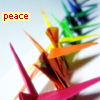 In Japan the Crane has always been a symbol of good luck, but one little girl changed it into a symbol of Peace for Japan.
In Japan the Crane has always been a symbol of good luck, but one little girl changed it into a symbol of Peace for Japan.This is her story...
Sadako and the Peace Crane
quoted from bbb.co.uk
'... on the 6 August, 1945, at 8.15am, Japanese Standard Time. An atomic bomb was dropped on the city of Hiroshima. The atomic bomb exploded 564 metres (1,850 feet) above the ground. Nearly all the buildings within 2.4 km (1.5 miles) were flattened. About 80,000 people died instantly from the blast. Another 70,000 died within a year, from injuries and from the fallout of nuclear radiation in the area surrounding the bomb's detonation.
The deaths did not stop there. Around 200,000 people have died because of this bomb alone. Many died because of illnesses brought about from the high levels of nuclear radiation to which they were exposed from living in and around Hiroshima.
One young Japanese girl named Sadako Sasaki was born in 1943. She was only two years old when the bomb was dropped on Hiroshima. Although she was too young to remember the war, every year she took part in the Peace Celebrations in Hiroshima because her grandmother died during the war. As Sadako grew up, she was strong, courageous and athletic. In 1955, she was preparing for a big race when she became dizzy and fell down. She was diagnosed with leukaemia, a cancer caused by radiation fallout, the 'atom bomb disease'. She was only 11 years old.
The illness changed Sadako's life. She was unhappy because she could not go to school, go out running or do the activities she had so enjoyed. However, she knew that some people recover from leukaemia so she never gave up hope.
One day her best friend Chizuko came to visit her and she told Sadako a story to cheer her up. The story was about a bird, a crane which was supposed to live for 1,000 years.
In Japan the crane is known as 'the bird of happiness' and is often referred to as 'Honourable Lord Crane'.
...the crane's reputation for long life and prosperity became a symbol of good health, and origami cranes became a popular gift for those who were ill. The story said that anyone who was ill should make 1,000 paper cranes and the gods would grant them a wish.
Sadako hoped that the gods would grant her wish to get well so that she could run again. Her friend, Chizuko showed her how to make a crane using origami, the ancient Japanese art of paper folding, and Sadako set to work.
All her visitors brought brightly coloured pieces of paper for her to make the cranes and Sadako's brother hung the finished ones from the ceiling of her room in the hospital.
Sadly, Sadako only managed to complete 644 paper cranes before dying on the 25 October, 1955, at the age of 12. The remaining 356 cranes were folded by her school friends so that she could be buried with 1,000 paper cranes.
Sadako had not given up, she continued to make paper cranes until she died. Sadako's friends were inspired by her courage and determination. They collected the letters that she had written and published them in a book called Kokeshi. Young people all over Japan were touched by her story and raised money to build a monument to her and all of the children killed by the atom bomb.
In 1958 the memorial was unveiled. It is a statue of Sadako holding a golden crane and is in the Hiroshima Peace Park, in Hiroshima, Japan.Robert Atendido, took this picture in April of 2003.
It shows the structures that were built to protect the paper cranes from the elements.
The statue is engraved at the bottom with the wish the children made:This is our cry, This is our prayer, Peace in the world.
Every year on Peace Day people from all over the world fold paper cranes and send them to Sadako's statue in Hiroshima.'
You can find more survivors' stories, and tapes, here at testimony_of_hibakusha.
"I will write 'peace' on your wings and you will fly all over the world"
Sadako Sasaki...

No comments:
Post a Comment
Note: only a member of this blog may post a comment.